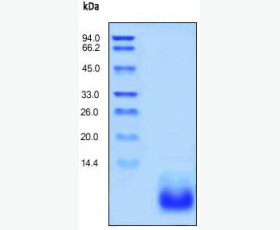Recombinant Human Kallikrein 11/KLK11
| Product name: | Recombinant Human Kallikrein 11/KLK11 |
| Source: | Human Cells |
| Purity: | Greater than 95% as determined by reducing SDS-PAGE. |
| Buffer Formulation: | Supplied as a 0.2 μm filtered solution of 20mM TrisHCl, 150mM NaCl, 2mM CaCl2, pH 8.0. |
| Applications: | Applications:SDS-PAGE; WB; ELISA; IP. |
| Storage: | Avoid repeated freeze/thaw cycles. Store at 2-8 oC for one month. Aliquot and store at -80 oC for 12 months. |
| UOM: | 100ug/50ug/200ug/1mg/1g |
| Source | Human Cells |
| Description | Recombinant Human Kallikrein 11 is produced by our Mammalian expression system and the target gene encoding Glu19-Asn250 is expressed with a 6His tag at the C-terminus. |
| Names | Kallikrein-11, hK11, Hippostasin, Serine Protease 20, Trypsin-Like Protease, KLK11, PRSS20, TLSP |
| Accession # | Q9UBX7 |
| Formulation | Supplied as a 0.2 μm filtered solution of 20mM TrisHCl, 150mM NaCl, 2mM CaCl2, pH 8.0. |
| Shipping |
The product is shipped on dry ice/ice packs. |
| Storage |
Store at < -20°C, stable for 6 months after receipt. Please minimize freeze-thaw cycles. |
| Purity |
Greater than 95% as determined by reducing SDS-PAGE. |
| Endotoxin | Less than 0.1 ng/µg (1 IEU/µg) as determined by LAL test. |
| Amino Acid Sequence |
ETRIIKGFECKPHSQPWQAALFEKTRLLCGATLIAPRWLLTAAHCLKPRYIVHLGQHNLQKEEGC EQTRTATESFPHPGFNNSLPNKDHRNDIMLVKMASPVSITWAVRPLTLSSRCVTAGTSCLISGWG STSSPQLRLPHTLRCANITIIEHQKCENAYPGNITDTMVCASVQEGGKDSCQGDSGGPLVCNQSL QGIISWGQDPCAITRKPGVYTKVCKYVDWIQETMKNNVDHHHHHH
|
| Background | Human Kallikrein 11 (KLK11) is a member of tissue kallikrein family which are extracellular serine proteases consisting of 15 members. Two isoforms of KLK11 are differentially expressed. Isoform 1 is predominantly expressed in brain and isoform 2 is preferentially expressed in prostate. Isoform 1 consists of a signal peptide,a short pro peptide and the mature chain.Isoform 2 contains an extra 32 amino acid N terminal to full-length isoform 1.KLK11 is a novel marker for ovarian and prostate cancer carcinomas. KLK11 can be activated by thermolysin and is active against a thioester substrate. |














